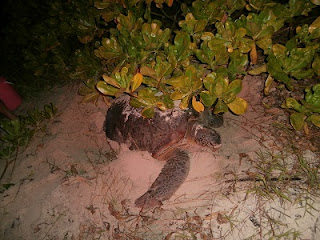Pom Pom should have been called turtle island, from the
moment I arrived I saw turtle after turtle swimming around in the ocean. I got
so excited at seeing these beautiful creatures in the flesh that I couldn’t help
but swim after each one, tiring myself out within a short space of time of racing
up and down the reef! The turtles would either be resting on coral or just
merrily swimming around, some were 1m plus and some smaller but each one was as
graceful as the next and just as exciting to see.
On my fifth night here I got
to see a turtle nesting!!! It was an amazing experience a huge 1m female laid
101 eggs and I got to share in this beautiful moment.
Steve was briefing the
guests on turtle ‘antics’ (he is pretty much a walking encyclopaedia when it
comes to marine life) and I was getting slowly more and more annoyed with my
camera as it was brand new and I hadn’t yet worked out how to use the night
vision and film settings. I was silently going mental at the fact that I couldn’t
capture this rare moment, but luckily managed to get a few good shots in the
end.
More information on volunteering with TRACC - Facebook page - pom pom island biodiversity - Marine biology courses -
2.5.12
Masters Project On Pom Pom Island
Pom Pom Island, there is only one word to describe it....paradise. I arrived
here on Pom Pom on the 18th of April
2012 and literally felt like I had stepped into paradise. The view of the
island from the boat was just breathtaking, turquoise water, white sands. I was
overwhelmed with excitement at the fact that I was going to stay in this beautiful
place for my masters project! As I got off the boat I was greeted so nicely by
all the staff and instantly felt at home. Something told me this was going to
be a good three months.
My time here will be devoted to conducting fieldwork for my Msc project with Professor Steve Oakley as my mentor, on the soft coral Parerythropodium fulvum fulvum. Yes, I know it is a mouthful hence Steve named it ‘the yellow triffid’ due to its fast growth rate and ability to grow over a lot of coral and substrate. I will be looking specifically at this growth rate and how it is affected by depth, current and location which is something that has not been looked at before with regards to this species thus will be answering numerous ecological and biological questions with regards to this species.
After growing the yellow
triffid in the coral nursery at depths of 3-5m (we went to Pandanan Island to
collect a surplus of yellow triffid and then placed fragments of it on 15×15cm concrete
blocks and letting it grow for two weeks) we plan to go to 6 different locations (regional
island reefs varying by current intensity and ecology) and place the coral at
varying depths of 5,10,15,20,25 m along a transect and recording the growth
rate at 2 week intervals. This will be done by photographing each block of
yellow triffid and working out the increase in horizontal growth using a design
software programme called AutoCAD. This is easily feasible due to the fast
growth rates observed by this species.
If I have time I will try and also look at what might be predating on the yellow triffid as it has been observed that colonies of yellow triffid in the wild only increase upto a certain size. Thus something very obsecure and not obvious has to be predating on it, as it has yet to be seen. I would also like to look at competition of yellow triffid with numerous aggressive hard corals as I have observed it growing over only some species of hard coral in the wild and it has not been able to grow over other species. Determination of these specific species would increase knowledge of this species of soft coral has not been studied in great depth.
 |
| The beautiful island of Pom Pom |
My time here will be devoted to conducting fieldwork for my Msc project with Professor Steve Oakley as my mentor, on the soft coral Parerythropodium fulvum fulvum. Yes, I know it is a mouthful hence Steve named it ‘the yellow triffid’ due to its fast growth rate and ability to grow over a lot of coral and substrate. I will be looking specifically at this growth rate and how it is affected by depth, current and location which is something that has not been looked at before with regards to this species thus will be answering numerous ecological and biological questions with regards to this species.
 |
| Parerythropodium fulvum fulvum. ‘the yellow triffid’ |
If I have time I will try and also look at what might be predating on the yellow triffid as it has been observed that colonies of yellow triffid in the wild only increase upto a certain size. Thus something very obsecure and not obvious has to be predating on it, as it has yet to be seen. I would also like to look at competition of yellow triffid with numerous aggressive hard corals as I have observed it growing over only some species of hard coral in the wild and it has not been able to grow over other species. Determination of these specific species would increase knowledge of this species of soft coral has not been studied in great depth.
More information on volunteering with TRACC - Facebook page - pom pom island biodiversity - Marine biology courses -
Labels:
borneo,
marine biology,
marine life,
marine research,
masters,
msc marine,
sabah,
scuba,
Semporna,
volunteer,
volunteer diver,
Volunteer Life
Location:
Pulau Pom Pom, Malaysia
Subscribe to:
Comments (Atom)


